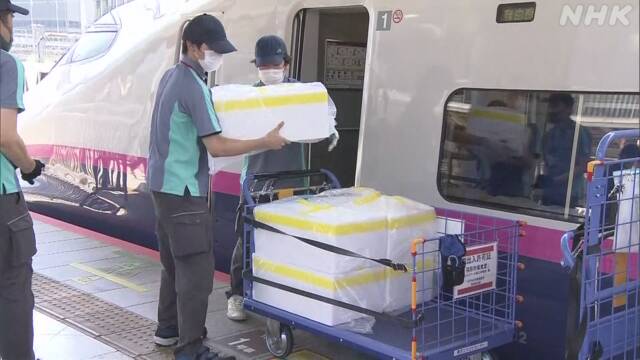Started transportation test of seafood from Miyagi on the Shinkansen, which has been reduced in use with the new Corona 16:49, August 26
Since the number of passengers on the Shinkansen has dropped significantly due to the new coronavirus, JR East has begun an experiment to transport fresh seafood from Miyagi prefecture to Tokyo for the first time using the seats on the Shinkansen.
Due to the impact of the new coronavirus, the number of passengers on the Tohoku Shinkansen is only 30% of the same period last year as of last week.
For this reason, JR East was the first to conduct an experiment to transport local specialty products to Tokyo using vacant seats.
On the 26th, squirts and oysters from Miyagi prefecture, which were landed on the morning of the same day, were transported to the Tohoku Shinkansen departing Sendai Station about 140 km before 11:00 am.
In the first car used for transportation, the two rows of seats were faced to each other, and the seafood was put in a special box to keep the air cool so that the freshness of the seafood was preserved.
The Shinkansen arrived at Tokyo Station in about two hours, and was served as sashimi and vinegared food at the seafood restaurant on the premises after 2:00 pm.
According to the fishermen who participated in the initiative, when it comes to transportation by truck, it often arrives in Tokyo the next day, but if you use the Shinkansen, you can shorten the time until it is provided at restaurants by a whole day. is.
Since JR can deliver seafood in a fresher condition, we believe that there is demand for carrying it on the Shinkansen, and we are aiming for practical use while proceeding with verification.
Tsuyoshi Hamada of the JR East supply chain management project said, "Since the Shinkansen is strong in speed and punctuality, we want to contribute to the community by carrying local products."
Tohoku Shinkansen usage status
The use of the Tohoku Shinkansen has dropped significantly due to the impact of the new coronavirus, and the number of passengers in May, when the emergency was announced, dropped to 10% of the same period last year.
Since then, the number of passengers has been gradually recovering, but last week it remained at about 30% of the same period last year, and it is expected that this situation will continue for a long time.
For this reason, JR East is extensively considering measures to compensate for the decline in revenues from the railway business, and as one of them, has begun an experiment to transport local specialty products to Tokyo by the Shinkansen.
JR will continue to verify the time required for transportation from the production area and aim to put it into practical use while also observing the reaction of passengers on the train.
Fisheries expectations
The fishermen in Ishinomaki, who participated in the experiment, had a decline in sales to restaurants due to the effect of the new coronavirus, and the sales in April were about 20% of the normal year and about 80% last month.
Until now, we used to transport seafood to markets and restaurants in Tokyo by truck, but marine products taken in the early morning are often delivered to restaurants and other places after noon on the next day, and in a fresher condition. Sending was a challenge.
Among them, sea squirts, which are a specialty of Miyagi prefecture, tend to shrink and lose their freshness after a long time since they were landed, so their consumption in the Tokyo metropolitan area, which takes a long time to transport, was sluggish.
In this experiment, the time required for delivery is shortened by one day compared to trucks, so it will be possible to provide it in a fresher state, which is expected to lead to increased consumption in the Tokyo metropolitan area.
Hiromitsu Ito, president of the fishery industry Kaiyu, said, "Since freshness is the key to marine products, I think this is an epoch-making thing that will revolutionize logistics."

